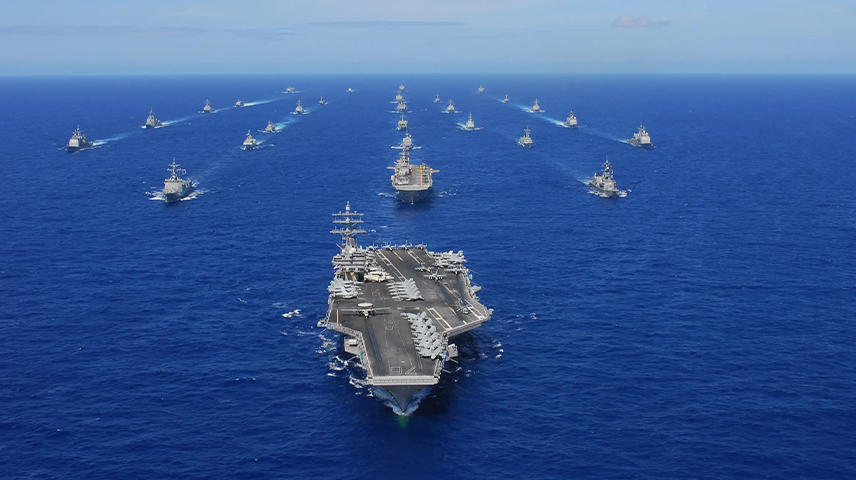Last January, a compelling report published by The Economist bore the captivating title "Welcome to the new era of global sea power." This insightful piece posited that oceans, once relegated to the periphery of geopolitical discourse, have now reclaimed their central role in shaping the contours of the international power landscape. The report aptly underscored the burgeoning U.S.-China rivalry for naval supremacy in Asia, amidst Beijing's assertive ventures into international waters and strategic port acquisitions across the globe. These developments present a stark contrast to the discourse of two decades ago regarding the importance of naval power in today's world.
In the English language, there is a nuanced distinction between two terms: "Naval Power" and "Sea Power." The former refers to the military capabilities of naval forces, including operations conducted on, under, or above the sea, which contribute to national defense, security, and broader state interests. On the other hand, "Sea Power" encompasses the maritime environment and the positive correlation between maritime elements and a nation's power. It extends beyond naval capabilities to include economic, civil, and intellectual domains, with impacts that go beyond short-term horizons or military considerations. The concept of Sea Power represents the symbiotic relationship between maritime navigation culture, naval might, economic growth, and global hegemony. This comprehensive understanding of Sea Power serves as the foundation for contemporary global competition between established and rising powers.
Reflecting on an interview conducted sixteen years ago at his residence in New Haven, Connecticut, the distinguished political scholar Paul Kennedy was queried about the pivotal factors underpinning the rise or fall of great powers, as elucidated in his seminal literary work. With characteristic acumen, the erudite British academic unequivocally highlighted "naval power" as the paramount factor still delineating the capacity of great powers to maintain their global standing. He specifically mentioned the United States, which has nearly 20 fleets controlling important maritime chokepoints and corridors around the world. According to Kennedy, "As long as the United States maintains its strong naval power and allocates resources wisely, it can uphold its position."
However, while Kennedy staunchly adhered to his convictions regarding the enduring significance of naval power in the global hierarchy, dissenting voices emerged, challenging the trajectory of naval power. Prevailing beliefs in strategic and military circles over the past three decades have suggested a diminished role for naval power due to a confluence of factors. The end of the Cold War marked the cessation of the primary focus on containing the Soviet Union, where naval forces played a pivotal role in maritime surveillance and power projection. With the demise of this unique threat paradigm, some opined that naval power waned in relevance. Additionally, the rise of asymmetric warfare has engendered unconventional threats such as terrorism and piracy, casting doubt on the efficacy of large naval forces in addressing these non-traditional adversaries. A shift in focus occurred, with a particular emphasis on ground forces and intelligence gathering. This shift was prompted by the prolonged land wars in Iraq and Afghanistan, which diverted resources and attention away from naval modernization and the formulation of comprehensive maritime strategies.
However, in the past decade, there have been transformative developments that have reshaped previous narratives. These developments have heralded the resurgence of sea power and maritime hegemony as key elements of global dominance in the twenty-first century, reminiscent of bygone epochs. Among these transformative developments is China's rapid expansion of its naval forces and its pursuit of maritime dominance to secure trade routes and assert regional claims. Beijing's construction of new aircraft carriers, destroyers, and submarines poses a formidable challenge to entrenched U.S. naval supremacy in the Indo-Pacific region. This expansion has galvanized regional actors, notably India, which recognizes the imperative of matching Beijing's maritime ambitions by bolstering indigenous shipbuilding capabilities and acquiring advanced weaponry. New Delhi's maritime expansion aims to fortify coastal defences and counter Chinese influence in the Indian Ocean. Similarly, nations like Japan and South Korea are making significant investments to enhance their naval capabilities to safeguard national interests and deter regional threats.
Furthermore, the escalating competition for control over vital maritime trade routes, highlighted by renewed U.S. and allied efforts to ensure unhindered maritime access and protect critical economic arteries, is driving renewed attention towards sea power. Recent confrontations in the Red Sea between Western naval forces and Houthi insurgents emphasize the pivotal role of maritime warfare in future global contingencies. The mounting tensions in critical maritime chokepoints like the Strait of Hormuz and the South China Sea indicate imminent flashpoints where rival naval capabilities will be prominently showcased. Complementing these geopolitical currents are advancements in domains such as unmanned aerial vehicles, electronic warfare, and anti-ship missile systems, which are precipitating a paradigm shift in naval warfare. Naval forces are compelled to adapt and integrate these technological innovations to maintain their ascendancy.
In summary, the emergence of new threats and increased competition for resources underscore the need to enhance strong naval capabilities to uphold global security and promote economic prosperity. Despite the ambitious strides of rising powers, the U.S. Navy remains the preeminent naval force globally, albeit encountering challenges in maintaining its dominance against emerging competitors. In its effort to uphold supremacy, the United States is spearheading the deployment of cutting-edge technologies like hypersonic ballistic missiles and unmanned aerial vehicles to maintain its advantage in maritime operations.
From the foregoing exposition, it is evident that oceans have become central arenas for commercial competition, scientific cooperation, and maritime rivalry. They are no longer mere elements of globalization but their essence. Approximately 85% of global trade is conducted via the seas, and nearly two-thirds of the world's oil and gas supplies are either found in or transported through maritime routes to their final destinations. These are but some of the indicators that fuel the escalating naval arms race, which is centered in the Western Pacific but rapidly extending to the Arctic, Indian Ocean, Atlantic, and recently, the Southern Red Sea region.


